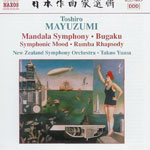Among the more fascinating things about this program of orchestral works is the sheer diversity of styles used by Japanese composer Toshiro Mayuzumi (1929-1997). The four compositions span only 14 years but they show an aurally adventurous young composer (he was between 19 and 33 years old when he wrote them), rapidly growing in skills and self-assurance while restlessly shifting styles. Just to consider the two mature works–Mandala-Symphony (1960) and Bugaku (1962)–you can readily hear chords and rhythms evoking Stravinsky and Varèse, clouds of string portamentos recalling Ligeti and Xenakis, Webernesque serial-sounding pointillism, and deliberate influences from classic imperial court music and Buddhist chant. Yet it all merges as in a musical melting pot and becomes a unique personal style. These two compositions are first-rate works, avant-garde in some respects but successfully designed to grip the listener’s attention.
The other two works are student pieces. Symphonic Mood (1950) is a worthy if texturally simple work that’s also adorned by multiple styles. It starts quietly, establishes a rhumba rhythm, then incongruously lays Balinese gamelan figurations on top of that. (The Imperial government until 1945 banned European and North American music, letting South American music in along with that of other Asian traditions. Mayuzumi was trying to be exotic and used what he knew, and somehow Symphonic Mood makes a virtue out of this musical mismatch.
On the other hand, Rhumba Rhapsody is sheer juvenilia–poorly shaped and of interest only to show how a composer can rescue good ideas from a bad composition, since the second movement of Symphonic Mood retools material from it. Mayuzumi’s progress is even more striking when you recall that during this same period he became Japan’s first and leading electronic music composer.
One aspect of Mayuzumi’s voice holds steady: His music is dynamic and rhythmically powerful at all tempos. Happily, conductor Takuo Yuasa conveys this vital dimension clearly in a performance showing that the New Zealand Symphony Orchestra deserves a high international reputation. The sound is also excellent. Mandala and Bugaku, if mated with works of equal value and with the same technical achievements, would rate a 10/10. Now can we ask someone for a good multi-channel recording of Mayuzumi’s masterwork, the Nirvana-Symphony?
































